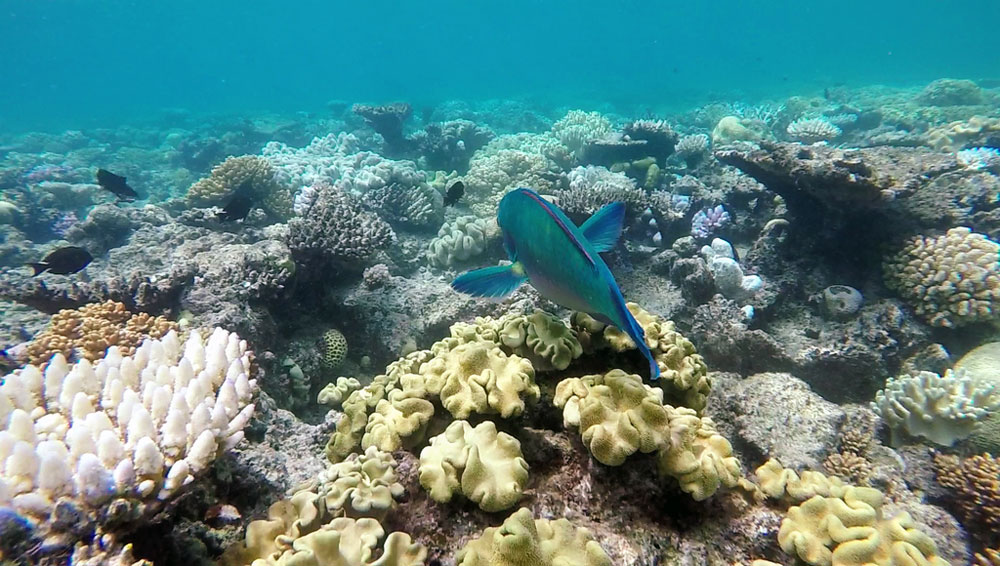
December 6, 2020; ABC News
The conservation status for Australia’s Great Barrier Reef has fallen from “significant concern” to “critical,” according to the International Union for Conservation of Nature’s (IUCN) 2020 World Heritage Outlook report, which tracks 252 natural World Heritage sites.
Global heating is to blame. As Julia Jacobo writes for ABC News, “The process of coral bleaching occurs when water is too warm and the algae the corals expel from their tissues cause them to turn completely white.” The decline of the coral has resulted in decreasing populations of certain marine species. The reef houses more than 1,500 species of fish.
The IUCN is the official advisory body on nature to the UNESCO (United Nations Education, Scientific and Cultural Organization) World Heritage Committee. This is the third report in the World Heritage Outlook series, with previous reports issued in 2014 and 2017. All told, 18 sites—seven percent of the 252 world heritage sites—are, like the Great Barrier Reef, listed as being in critical condition.
A full list of World Heritage sites that are considered to be in critical condition is below:
Sign up for our free newsletters
Subscribe to NPQ's newsletters to have our top stories delivered directly to your inbox.
By signing up, you agree to our privacy policy and terms of use, and to receive messages from NPQ and our partners.
- Aïr and Ténéré Natural Reserves (Niger)
- Dja Faunal Reserve (Cameroon)
- East Rennell (Solomon Islands)
- Everglades National Park (United States)
- Garamba National Park (Democratic Rep. of the Congo)
- Great Barrier Reef (Australia)
- Islands and Protected Areas of the Gulf of California (Mexico)
- Kahuzi-Biéga National Park (Democratic Rep. of the Congo)
- Lake Turkana National Parks (Kenya)
- Manovo-Gounda St Floris National Park (Central African Republic)
- Mount Nimba Strict Nature Reserve (Côte d’Ivorie and Guinea)
- Niokolo-Koba National Park (Senegal)
- Okapi Wildlife Reserve (Democratic Rep. of the Congo)
- Río Plátano Biosphere Reserve (Honduras)
- Salonga National Park (Democratic Rep. of the Congo)
- Selous Game Reserve (Tanzania)
- Tropical Rainforest Heritage of Sumatra (Indonesia)
- Virunga National Park (Democratic Rep. of the Congo)
As was in true in the first two reports, the climate crisis continues to be the number-one threat to World Heritage sites. In 2020, climate change is listed as the “most prevalent current threat,” and it is assessed to be a “high” or “very high” threat in 83 of 252 sites. After the climate emergency, the next two largest threats to heritage sites are invasive alien species and tourism impacts.
In addition to the Great Barrier Reef, the islands and protected areas of Mexico’s Gulf of California have also entered the critical category, the report found. The other 16 sites on the list, including the Everglades in the US, were already on the critical list in 2017.
The report notes that overall, “A comparison between 2017 and 2020 shows that a total of 24 sites changed their overall conservation outlook, with 16 deteriorating and only eight improving.” By contrast, between 2014 and 2017, 14 sites improved and only 12 deteriorated.
As for the Great Barrier Reef, the downgrade of its condition is hardly surprising. As one account noted, “Earlier this year, scientists in Australia revealed that the Great Barrier Reef has suffered one of the most extensive coral bleaching events in March 2020 raising concerns as the reefs recovered less each time after the process. This was the third extensive bleaching in over the last five years. Director of the ARC Centre of Excellence for Coral Reef Studies at James Cook University, Terry Hughes, said that February 2020 was the hottest month on record in the Great Barrier Reef since records began in 1900.”—Steve Dubb












